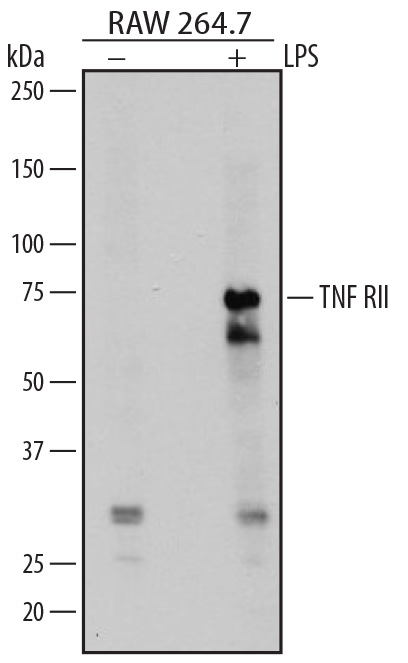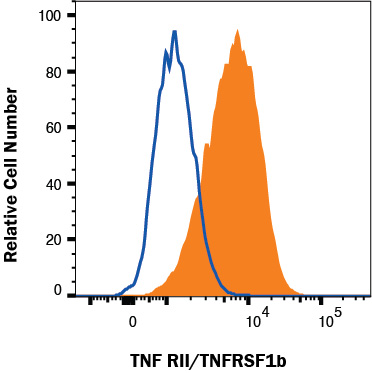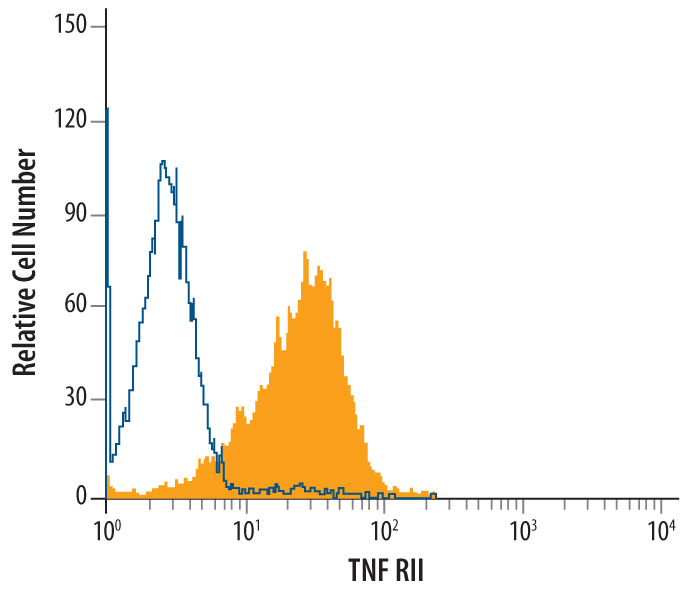Mouse TNF RII/TNFRSF1B Antibody Summary
Val23-Gly258
Accession # P25119
Applications
This antibody functions as an ELISA detection antibody when paired with Rat Anti-Mouse TNF RII/TNFRSF1B Monoclonal Antibody (Catalog # MAB4263).
This product is intended for assay development on various assay platforms requiring antibody pairs. We recommend the Mouse sTNF RII/TNFRSF1B DuoSet ELISA Kit (Catalog # DY426) for convenient development of a sandwich ELISA or the Mouse/Rat TNF RII/TNFRSF1B Quantikine ELISA Kit (Catalog # MRT20) for a complete optimized ELISA.
Please Note: Optimal dilutions should be determined by each laboratory for each application. General Protocols are available in the Technical Information section on our website.
Scientific Data
 View Larger
View Larger
Detection of Mouse TNF RII/TNFRSF1B by Western Blot. Western blot shows lysates of RAW 264.7 mouse monocyte/macrophage cell line untreated (-) or treated (+) with 1 µg/mL LPS for 24 hours. PVDF membrane was probed with 0.2 µg/mL of Goat Anti-Mouse TNF RII/TNFRSF1B Antigen Affinity-purified Polyclonal Antibody (Catalog # AF-426-PB) followed by HRP-conjugated Anti-Goat IgG Secondary Antibody (Catalog # HAF109). A specific band was detected for TNF RII/TNFRSF1B at approximately 75 kDa (as indicated). This experiment was conducted under reducing conditions and using Immunoblot Buffer Group 1.
 View Larger
View Larger
Detection of TNF RII/TNFRSF1B in Raw264.7 Mouse Cell Line by Flow Cytometry. Raw264.7 mouse macrophage cell line, resting (open histogram) or treated with 1 μg/mL LPS overnight (filled histogram), was stained with Goat Anti-Mouse TNF RII/TNFRSF1B Antigen Affinity-purified Polyclonal Antibody (Catalog # AF-426-PB), followed by Allophycocyanin-conjugated Anti-Goat IgG Secondary Antibody (F0108). Staining was performed using our Staining Membrane-associated Proteins protocol.
 View Larger
View Larger
Detection of TNF RII/TNFRSF1B in L‑929 Mouse Cell Line by Flow Cytometry. L-929 mouse fibroblast cell line was stained with Goat Anti-Mouse TNF RII/TNFRSF1B Antigen Affinity-purified Polyclonal Antibody (Catalog # AF-426-PB, filled histogram) or control antibody (Catalog # AB-108-C, open histogram), followed by Allophycocyanin-conjugated Anti-Goat IgG Secondary Antibody (Catalog # F0108).
 View Larger
View Larger
TNF RII/TNFRSF1B in L‑929 Mouse Cell Line. TNF RII/TNFRSF1B was detected in immersion fixed L‑929 mouse fibroblast cell line using Goat Anti-Mouse TNF RII/TNFRSF1B Antigen Affinity-purified Polyclonal Antibody (Catalog # AF-426-PB) at 1.7 µg/mL for 3 hours at room temperature. Cells were stained using the NorthernLights™ 557-conjugated Anti-Goat IgG Secondary Antibody (red; NL001) and counterstained with DAPI (blue). Specific staining was localized to cytoplasm. Staining was performed using our protocol for Fluorescent ICC Staining of Non-adherent Cells.
Reconstitution Calculator
Preparation and Storage
- 12 months from date of receipt, -20 to -70 °C as supplied.
- 1 month, 2 to 8 °C under sterile conditions after reconstitution.
- 6 months, -20 to -70 °C under sterile conditions after reconstitution.
Background: TNF RII/TNFRSF1B
Two types of soluble TNF receptors have been identified in human serum and urine which can neutralize the biological activities of TNF-alpha and TNF-beta. These binding proteins represent truncated forms of the two types of high-affinity cell surface receptors for TNF (TNFR-p60 Type B and TNFR-p80 Type A). Soluble TNF RII corresponds to TNFR-p80 Type A. In the new TNF superfamily nomenclature, TNF RII is referred to as TNFRSF1B. These apparent soluble forms of the receptors appear to arise as a result of shedding of the extracellular domains of the membrane-bound receptors. Normal concentrations as high as 4 ng/mL are found in the serum of healthy individuals, and even higher levels may be found in some pathological conditions. Although the physiological role of these proteins is not known, it has been speculated that shedding of the soluble receptors in response to TNF release could serve as a mechanism to scavenge the TNF not immediately bound and thus localize the inflammatory response. It is also possible that the pool of TNF bound to soluble receptors could represent a reservoir for the controlled release of TNF.
Product Datasheets
Citations for Mouse TNF RII/TNFRSF1B Antibody
R&D Systems personnel manually curate a database that contains references using R&D Systems products. The data collected includes not only links to publications in PubMed, but also provides information about sample types, species, and experimental conditions.
8
Citations: Showing 1 - 8
Filter your results:
Filter by:
-
The Inflammatory Response after Moderate Contusion Spinal Cord Injury: A Time Study
Authors: MC Lund, DG Ellman, M Nissen, PS Nielsen, PV Nielsen, C Jørgensen, DC Andersen, H Gao, R Brambilla, M Degn, BH Clausen, KL Lambertsen
Biology, 2022-06-20;11(6):.
Species: Mouse
Sample Types: Whole Cells, Whole Tissue
Applications: ICC, IHC -
Novel strategies to mimic transmembrane tumor necrosis factor-dependent activation of tumor necrosis factor receptor 2
Authors: R Fischer, J Marsal, C Guttà, SA Eisler, N Peters, JR Bethea, K Pfizenmaie, RE Kontermann
Sci Rep, 2017-07-26;7(1):6607.
Species: Mouse
Sample Types: Whole Cells
-
Endogenous TNF? orchestrates the trafficking of neutrophils into and within lymphatic vessels during acute inflammation
Authors: S Arokiasamy, C Zakian, J Dilliway, W Wang, S Nourshargh, MB Voisin
Sci Rep, 2017-03-13;7(0):44189.
Species: Mouse
Sample Types: Whole Cells
Applications: Flow Cytometry -
Phenotypic screening reveals TNFR2 as a promising target for cancer immunotherapy
Oncotarget, 2016-10-18;0(0):.
Species: Mouse
Sample Types: Whole Cells
Applications: Flow Cytometry -
Therapy of peritoneally disseminated colon cancer by TAP-deficient embryonic stem cell-derived macrophages in allogeneic recipients.
Authors: Haga E, Endo Y, Haruta M, Koba C, Matsumura K, Takamatsu K, Ikeda T, Nishimura Y, Senju S
J Immunol, 2014-07-16;193(4):2024-33.
Species: Mouse
Sample Types: Whole Cells
Applications: Flow Cytometry -
Myosin light chain kinase expression induced via tumor necrosis factor receptor 2 signaling in the epithelial cells regulates the development of colitis-associated carcinogenesis.
Authors: Suzuki M, Nagaishi T, Yamazaki M, Onizawa M, Watabe T, Sakamaki Y, Ichinose S, Totsuka M, Oshima S, Okamoto R, Shimonaka M, Yagita H, Nakamura T, Watanabe M
PLoS ONE, 2014-02-10;9(2):e88369.
Species: Mouse
Sample Types: Cell Lysates
Applications: Western Blot -
Pericytes support neutrophil subendothelial cell crawling and breaching of venular walls in vivo.
Authors: Proebstl D, Voisin MB, Woodfin A, Whiteford J, D'Acquisto F, Jones GE, Rowe D, Nourshargh S
J. Exp. Med., 2012-05-21;209(6):1219-34.
Species: Mouse
Sample Types: Whole Tissue
Applications: IHC -
TNF-alpha drives remodeling of blood vessels and lymphatics in sustained airway inflammation in mice.
Authors: Baluk P, Yao LC, Feng J, Romano T, Jung SS, Schreiter JL, Yan L, Shealy DJ, McDonald DM
J. Clin. Invest., 2009-09-14;119(10):2954-64.
Species: Mouse
Sample Types: Whole Tissue
Applications: IHC-Fr
FAQs
No product specific FAQs exist for this product, however you may
View all Antibody FAQsReviews for Mouse TNF RII/TNFRSF1B Antibody
There are currently no reviews for this product. Be the first to review Mouse TNF RII/TNFRSF1B Antibody and earn rewards!
Have you used Mouse TNF RII/TNFRSF1B Antibody?
Submit a review and receive an Amazon gift card.
$25/€18/£15/$25CAN/¥75 Yuan/¥2500 Yen for a review with an image
$10/€7/£6/$10 CAD/¥70 Yuan/¥1110 Yen for a review without an image





